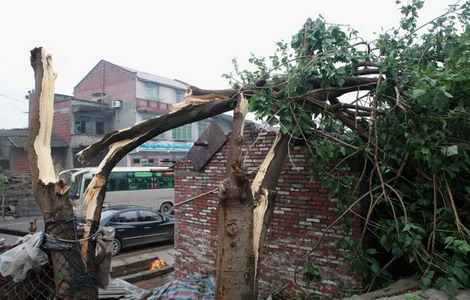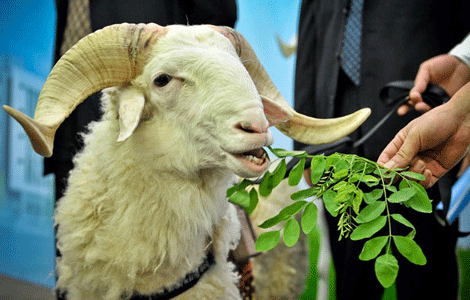
Producing China's own version of the BBC's Discovery documentaries is what occupies the mind of Yan Baoping.
Over the past seven years, she has produced tons of video footage, recording the lives of endangered birds in uninhabited areas, thanks to network camera surveillance systems she and her team have developed and installed in nature reserves in Qinghai province and the Xinjiang Uygur autonomous region.
Some of the footage has recorded moments even bird experts have never seen, she said.
Some of the most memorable and notable have been on the breeding patterns of black-necked cranes, at Qinghai Lake — one of the biggest breeding areas for the cranes, an endangered animal.
Yang Xiaojun, a senior researcher at the Chinese Academy of Sciences' Kunming Institute of Zoology who specializes in birds from southwestern China, said it is the first time black-necked cranes had ever been recorded breeding.
Yan, chief engineer of the Computer Network Information Center at the academy, said: "It's so exciting what technology can do for the protection of wildlife."
But the idea of setting up network camera surveillance systems at nature reserves was actually not planned.
In 2005, Qinghai Lake National Nature Reserve had reported the unusual deaths of more than 1,000 wild birds between May and July.
Autopsy results showed the birds died of avian influenza.
Suddenly, the reserve, known as China's haven for birds, faced accusations from abroad that migratory birds living at the Qinghai Lake were the source of the virus and might carry the epidemic to other countries.
To find out the truth, the forestry authority in Qinghai province suggested establishing a joint research center with the Chinese Academy of Sciences to study the migratory birds that stop at the lake to breed between May and October.
The academy's Institute of Zoology, Institute of Microbiology, and Wuhan Institute of Virology all sent experts to Qinghai, as did Yan's Computer Network Information Center.
At first, they planned to be there to help set up a database for zoologists, to assess the deaths, but IT engineers suggested it might be timely to set up a networked camera surveillance system.
The result was the first and biggest surveillance system in a reserve in China, said Yan.
Starting in 2006, 20 solar-powered surveillance cameras were installed to cover the wild birds' five major habitats in the lake from May to October each year, when migratory birds would stay for summer.
The cameras and the surveillance network solved a big problem for the reserve staff.
"These islets in the middle of Qinghai Lake are heaven for birds but are impossible for people to stay on for more than a few days," network expert Yan said.
Reserve workers can now monitor the wild birds all day, and detect any unusual signs.
The surveillance system proved to be a big help, and the team was subsequently invited to Xinjiang in 2010 to record a nest of buzzards.
Last year, they returned to record two black-necked crane pairs that were staying in the Quanwan area of Qinghai Lake.
But monitoring was more difficult than expected, Yan said.
"The cranes are clever. They can even detect a temperature sensor disguised as an egg that we put in their nest," she said.
"They are highly alert to changes in the environment, too, and are ready to abandon their nest and eggs whenever they feel threatened."
Before Yan's team installed the surveillance cameras in May, a Tibetan monk who lives in the area helped by moving a pole gradually closer to the cranes' nest, from 200 meters to 150 meters, finally to 10 meters, to get cranes used to the camera.
"But the cranes still flew away when they first saw the camera 2 meters from their nest," Yan said.
"For a while, we feared they might abandon the nest, built in waterweeds, and the two eggs in it. Fortunately, they came back."
This year, a networked surveillance system will be installed to monitor more wildlife, such as Tibetan antelope and blue sheep.
Yan said her team will help the Kekexili National Nature Reserve in Qinghai set up surveillance at underpasses built for Tibetan antelope beneath the Qinghai-Tibet railway, most of which is elevated, to record the animals' journey to breeding grounds.
The Kekexili reserve hopes the system will help count how many Tibetan antelopes are using the passes and how many calves they produce.
Yan's team will also start setting up a system in Sanjiangyuan Nature Reserve in Qinghai, the origin of the Yangtze, Yellow and Lancang rivers.
The system is expected to help monitor ecological changes and study wildlife.
Qinghai Lake National Nature Reserve officials have also put forward a new research subject for Yan's team to work on: to develop an underwater surveillance system to assess the population of a rare kind of coldwater fish that grows only 500 grams in 10 years in the salty plateau lake.
"We generally find our own research subjects, instead of following research trends in other countries," she said.
"I often joke with my colleagues that in the old days, IT experts stayed in labs all year and zoologists were out there in the field. Now it is the opposite.
"It's the IT experts spending months in the field installing surveillance cameras and the zoologists who stay in labs, using the footage we provide," she said.
xindingding@chinadaily.com.cn







